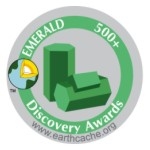Crockett Spring Earthcache EarthCache
Crockett Spring Earthcache
-
Difficulty:
-

-
Terrain:
-

Size:  (not chosen)
(not chosen)
Please note Use of geocaching.com services is subject to the terms and conditions
in our disclaimer.

CROCKETT SPRINGS

An artesian aquifer is a confined aquifer containing groundwater that will flow upwards out of a well without the need for pumping. An aquifer provides the water for an artesian well. An aquifer is a layer of soft rock, like limestone or sandstone, that absorbs water from an inlet path. Porous stone is crushed between impermeable rocks or clay. This keeps the pressure high, so when the water finds a hole, it defies gravity and goes up instead of down.
HISTORY OF CROCKETT SPRINGS
Crockett Spring is located in Crockett Spring Park at 200 Crockett Street in Rogersville, Tennessee. It is owned by The Heritage Association and permission for this Earthcache has been granted by the Director Ms. Patricia Humbert.
Crockett Spring is located in downtown Rogersville, TN in the central part of the town and Crockett Spring Park is a joint project of the Town and the Rogersville Heritage Association. The park is the site of Rogersville's first settlement, and the tavern and home built by founder Joseph Rogers is preserved on the site.
The Park also encompasses the Rogers Cemetery, where Joseph and Mary Rogers, many of their children, and the grandparents of Davy Crockett are buried.
In addition to these historic interests, the site of Rogersville's first public swimming pool is here, as is a gazebo built to commemorate the bicentennials of both the Town (1789) and the State (1796).
ARTESIAN SPRINGS
Water issuing from an artesian spring rises to a higher elevation than the top of the confined aquifer from which it issues. When water issues from the ground it may form into a pool or flow downhill, in surface streams. Sometimes a spring is termed a seep. Minerals become dissolved in the water as it moves through the underground rocks. This may give the water flavor and even carbon dioxide bubbles, depending upon the nature of the geology through which it passes.
Mineral water is water containing minerals or other dissolved substances that alter its taste or give it therapeutic value. Salts, sulfur compounds, and gases are among the substances that can be dissolved in the water. Mineral water can often be effervescent. Mineral water can be prepared or can occur naturally.
Springs may be formed in any sort of rock. Small ones are found in many places. In Missouri, the largest springs are formed in limestone and dolomite in the karst topography of the Ozarks.
Both dolomite and limestone fracture relatively easily. When weak carbonic acid (formed by rainwater percolating through organic matter in the soil) enters these fractures it dissolves bedrock. When it reaches a horizontal crack or a layer of non-dissolving rock such as sandstone or shale, it begins to cut sideways, forming an underground stream. As the process continues, the water hollows out more rock, eventually admitting an airspace, at which point the spring stream can be considered a cave. This process is supposed to take tens to hundreds of thousands of years to complete.
Origin of the word Artesian.
Artesian wells were named after the former province of Artois in France, where many artesian wells were drilled by Carthusian monks since 1126. [Frances Gies and Joseph Gies, "Cathedral, Forge, and Waterwheel" subtitled "Technology and Invention in the Middle Ages". Harper Perennial, 1995 ISBN 0-06-016590-1, page 112.] The technique was also known much earlier in Syria and Egypt, [For references on ancient uses, see Michel Wuttmann, [http://www.achemenet.com/pdf/jasr/jasr2000.1.pdf "The Qanats of 'Ayn-Manâwîr, Kharga Oasis, Egypt"] , in "Jasr" 2001, p. 1. and [http://www.carlo-bergmann.de/Discoveries/discovery.htm Discoveries in the Western Desert of Egypt] ] although whether the monks of Artois learned of it from outside sources or discovered it independently is unknown.
Springs are often classified by the volume of the water they discharge. The largest springs are called "first-magnitude".
Spring flow scale
0 Magnitude - no flow (sites of past/historic flow)
1st Magnitude - > 100 cubic feet per second (cfs)
2nd Magnitude - 10 to 100 cfs
3rd Magnitude - 1 to 10 cfs
4th Magnitude - 100 gal/min - 1 cfs (448 gal/min)
5th Magnitude - 10 to 100 gal/min
6th Magnitude - 1 to 10 gal/min
7th Magnitude - 1 pint to 1 gal/min
8th Magnitude - Less than 1 pint/min
Other nearby Earthcaches:
Ebbing and Flowing Spring Earthcache (GC1JYY3)
The Big Spring (GC1M15R)
Town Knobs Fault (GC1YRKG)
To log this cache, email me and tell me
1. What is your best estimate of the magnitude of this spring, at the above listed coordinates, according to the scale above and
2. What is the temperature of the water (bring a thermometer with you to take the temperature) and
3. Upload a photo of you and/or your group with a GPSr at the above coordinates with your "Find Log".
I request that you email your answers to me on the same day that you log your “found it” log. (This does not have to be the day you visit, just the day you log the find on the computer.) I also request that you do not log a “found it” log unless you have actually visited the site of the earthcache and sent the answers to me. The only person who really benefits from your visit is YOU.
Each cacher is required to send the required information and not rely on another cacher to provide it. Failure to follow this procedure will result in a deleted log. It is not my job to keep track of your group.
XXXXXXXXXXXXXXXXXXXXXXXXXXXXXXXXXXXXXXXXXXXXXXXXXXXXXXXXXXXXXXXXXXXXXXXXXXXXXXXX
We became Platinum Earthcache Masters on September 17, 2007.
We were the first to request and receive on July 2, 2011 the Emerald Discovery Award for finding 500 or more Earthcaches.
We received the Diamond Discovery Award on June 17, 2012 for finding 1,000 or more Earthcaches.



XXXXXXXXXXXXXXXXXXXXXXXXXXXXXXXXXXXXXXXXXXXXXXXXXXXXXXXXXXXXXXXXXXXXXXXXXXXXXXX

Additional Hints
(No hints available.)